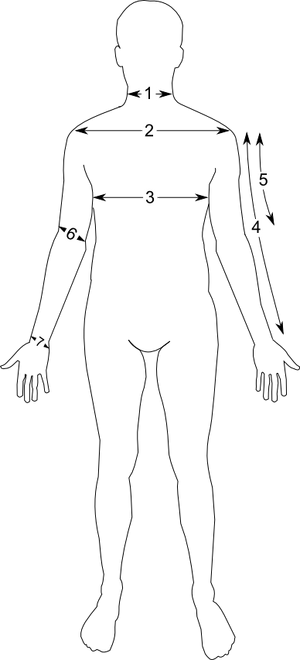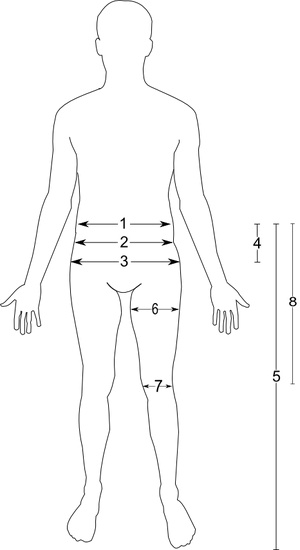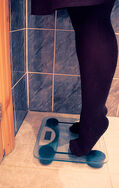Measurements are the basis of making clothing, particularly because you have to actually measure things to ensure that they will fit you correctly. This page lists the different types of measurements and how to take them, and clothing standards in the United Kingdom, European Union and United States.
Traditional[]
Although there is not specifically a type of measurement considered "traditional", I have tried to compound the other measurements which I have encountered in tailoring books which are distinct in that they do not fall into pre-defined increments or letter codes, but are general "rules of thumb" which relate to measurements of individual anatomy.
Reference lines/points[]
These lines and points are used as references to parts of the body where clothing will hang, but also where certain measurements should be made up to. They don't have specific measurements, they are just
| Reference | Description |
|---|---|
| Neckline |
The line which runs around the neck, which is easiest viewed by draping a chain or heavy string around the neck, which outlines the natural contour. |
| Neck planes | Used to provide an representation of the shape of the neck in three strokes; one for the vertical part of the neck, one for the angled part which joins the neck to the shoulder, and one which joins the shoulder to the neck angle. |
| Shoulder Point | The point at which the shoulder meets with the upper part of the arm, or, where the shoulder seam meets the sleeve seam. |
| Shoulder seam | The shoulder seam is the line that runs along the top of the shoulder from the slope of the neck inbetween the front and the back of the body. |
| The line which runs down the body from the mid-point of the shoulder slope over the backl or front towards the floor. | |
| The line which runs down the body from the mid-point of the front neck contour to the floor between the legs. |
Measurements[]
This guide distinguishes between the circumference measurement, which is around a body part, and a normal non-circumferencial measurement by the terminology of "circumference taken" and "measurement" respectively.
| Type | Measurement | Gender | Description |
|---|---|---|---|
| Girth | Neck | Both | The circumference of the neck, taken by measuring over the large vertebrae of the center back, and over the collar bone. Tape measure should trace the neckline and be snug but not tight. |
| Neck Width | Both | Taken by putting a string around the neck so that it falls vertically at either side of the neck, roughly outlining the width of the neck. The measurement is then taken between each string. | |
| Shoulder Width | Both | Taken parallel to the ground, measuring the distance between the left shoulder point and the right shoulder point. | |
| Chest | Male | Taken at the fullest part of the chest, with the measuring tape crossing over the shoulder blades at the back. | |
| Upper Chest | Female | The circumference taken of part of the chest above the bust, taken under the arm. | |
| Full Bust | Female | The circumference taken at the fullest part of the bust, and over the shoulder blades of the back. | |
| Front Bust | Female | The measurement across the fullest part of the bust from the left side-seam to the right side-seam. Where these measurements are taken is unclear; the best description is if hands were lifted up and a measure drawn directly down from the widest part of the shoulder until it intersected with the measurement given for the full-bust, then this point would be the beginning, and the end would be the same point on the other side of the body. | |
| Back Bust | Female | The measurements at the back, at the same height as the measurement taken for the front bust. | |
| Bust-Bust | Female | The measurement taken from the apex of one breast to the apex of the other. | |
| Rib Cage | Female | Circumference taken of the body taken below the level of the bust. | |
| Waist | Both | The region differs depending upon comfort, but the region of the waist is close to the belly-button, but normally it is the circumference of the waist taken at a position between the rib-cage and the hip bone. | |
| Bicep | Both | Circumference taken at the fullest part of the bicep. | |
| Wrist | Both | Circumference taken just below the large wrist bone. | |
| Palm | Both | Circumference taken at the largest part of the hand. | |
| Hips | Both | Circumference taken at the largest part of the hips. | |
| Thigh | Both | Circumference taken at the largest part of the thigh. | |
| Leg Width | Both | Measurement taken of the thigh from the largest part of the thigh at the front of the body to the largest part at the back. | |
| Knee | Both | Circumference taken at the knee cap. | |
| Length | Center-front-waist | Both | Measurement from the center-front of the neckline down to the waist. |
| Center-front-ribcage | Female | Measurement from the center-front of the neckline down to the ribcage. | |
| Center-front-knee | Female | Measurement from the center-front of the neckline down to the knee. | |
| Center-front-floor | Female | Measurement from the center-front of the neckline down to the floor. | |
| Side-front-bust | Women | Measurement from the side-front of the neckline (the mid-point of the neck curve where the neck meets the shoulder) down to the bust. | |
| Side-front-waist | Both | Measurement from the side-front of the neckline (the mid-point of the neck curve where the neck meets the shoulder) down to the waist. | |
| Shoulder-bust | Women | Measurement taken diagnonally from the apex of one breast to the shoulder point. | |
| Shoulder-waist | Male | Measurement taken from the point between the center-front and the waist, and the shoulder point. | |
| Armpit-waist | Both | Measurements taken by the use of two tape measures; one drawn in a straight line under the armpit to just beyond the upper arm, and then one drawn from this line down to the waist. | |
| Arm | Both | With the arm bent at the elbow, the measurement taken around the contour of the arm, over the back of the albow, from the shoulder point to the bottom of the large wrist bone. | |
| Shoulder-elbow | Both | Measurement of the same method as the arm measurement, but taken from the shoulder point to the | |
| Sleeve (Cap) | Both | Measurement taken by placing a rubber band around the upper part of the arm, and then measuring from the shoulder point to this area. | |
| Waist-hip | Both | Measurement taken from the waist to the fullest part of the hip. | |
| Waist-knee | Both | Measurement taken from the waist to the knee. | |
| Waist-floor | Both | Measurement taken from the waist to the floor. | |
| Inseam | Both | Measurement taken from the inside of the leg, along the leg, to the floor. | |
| Crotch | Both | Measurement taken from sitting from the side waist to the chair seat. |
Male Upper Body[]
|
Male Lower Body[]
|
Female Upper Body[]
Female Lower Body[]
Standards-based[]
The most common standards for clothing are those created by the International Standards Organisation, which designate the size of clothing. These are different from tailored clothing in that there are static, specific size types, rather than specific measurements.
International Standards[]
The International Standards for clothing size are:
- ISO 3635:1981 Size designation of clothes – Definitions and body measurement procedure
- ISO 4416:1981 Size designation of clothes – Women's and girls' underwear, nightwear, foundation garments and shirts
- ISO 5971:1981 Size designation of clothes – Pantyhose
- ISO 8559:1989 Garment construction and anthropometric surveys – Body dimensions
- ISO/TR 10652:1991 Standard sizing systems for clothes
American Standards[]
American standards seem to be quite behind. At the moment, the most-adhered-to standards seem to be International standards in the United States.
British Standards[]
British standards are the same as the International Standards but with different reference numbers, however, the standards are the same.
European Standards[]
These standards seem to have developed a lot of popularity in the United Kingdom. These standards came into effect in Europe in 2004 and have had varying adoption across Europe. The standard proscribes the use of a pictogram which details the various measurements of clothing, which is usually placed onto a piece of clothing.
The standards are:
- EN 13402-1: Terms, definitions and body measurement procedure
- EN 13402-2: Primary and secondary dimensions
- EN 13402–3: Measurements and intervals
Dimensions[]
Each one of the standards defines specific dimensions which are measured, and how to measure them, and in particular, defines letter codes which are specific sizes of clothing:
Letter codes[]
| Code | Description | Size |
|---|---|---|
| XXS | Extra Extra Small | |
| XS | Extra Small | |
| S | Small | |
| M | Medium | |
| L | Large | |
| XL | Extra Large | |
| XXL | Extra Extra Large | |
| 3XL | Extra Extra Extra Large |
Measurements[]
| Measurement | Description |
|---|---|
| Head girth | Maximum horizontal girth of the head measured above the ears. |
|
Neck girth |
Girth of the neck measured with a tape measure, passed 2cm below the Adam's Apple and at the level of the 7th cervical vertebra. |
|
Chest girth |
Maximum horizontal girth measured during normal breathing with the subject standing erect, and the tape measure passed over the shoulder blades (scapulae), under the armpits (axillae) and across the chest. |
|
Bust girth |
Maximum horizontal girth measured during normal breating, with the subject standing erect and the tape measure passed horizontally, under the armpits (axillae), and across the most prominent part of the bust. |
|
Underbust girth |
Horizontal girth measured just below the breasts. |
|
Waist girth |
Girth of the natural waistline between the top of the hip bones (iliac crests) and the lower ribs, measured with the subject breathing normally and standing erect with abdomen relaxed. |
|
Hip girth |
Horizontal girth measured round the buttocks at the level of the maximum circumference. |
|
Height |
Vertical distance between the crown of the head and the soles of the feet, with the subject standing erect without shoes, feet together. For infants who are not able to stand upright, the length of the body measured in a straight line from the crown of the head to the soles of the feet. |
|
Inside leg length |
Distance between the crotch and the soles of the feet, measured in a straight vertical line with the subject erect, feet slightly apart, and the weight of the body equally distributed on both legs. |
|
Arm length |
Distance measured using a tape-measure from the arms-eye/shoulder-line intersection (acromion), over the elbow, to the far end of the prominent wrist bone (ulna), with the subject's right fist clenched and placed on the hip with the arm bent at 90 degrees. |
|
Hand girth |
Maximum girth measured over the knuckles (metacarpals) of the open right hand, fingers together, and thumb excluded. |
|
Foot length |
Horizontal distance between the most prominent toe and the most prominent part of the heel, measured with the subject standing barefoot, with the weight of the body distributed on both feet. |
|
Body mass |
Measured in kilograms. |



